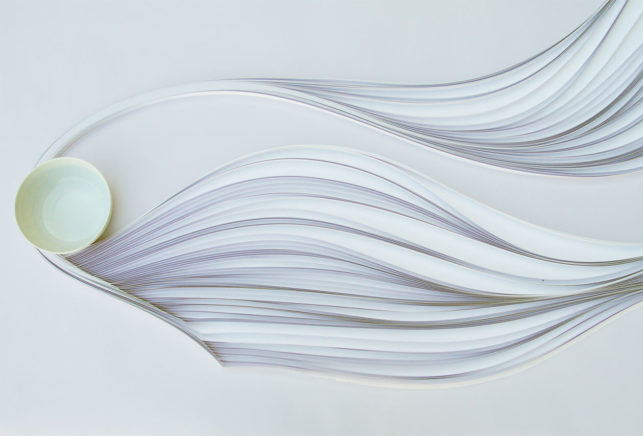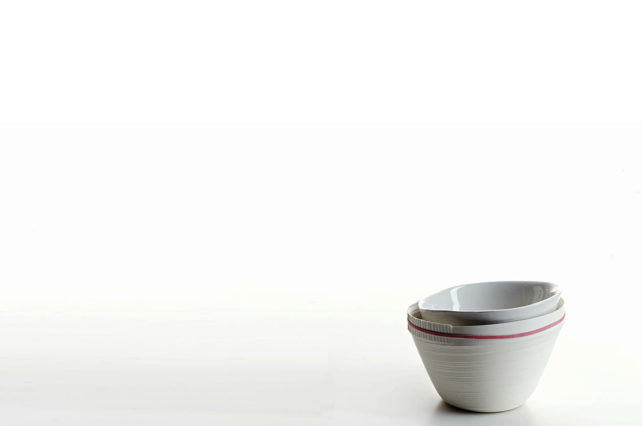VITTORIO PASSARO

Può l’eredità produttiva della tradizione coniugarsi e convivere con quella moderna, non rinchiudendosi in una prigione ma evolvendosi in una nuova visione?
Con il progetto Papyrus si è cercato di rispondere a questa domanda, lavorando alle radici del processo produttivo della porcellana, da cui si sono sviluppate inaspettatamente nuove modalità d’uso del prodotto, non decise a priori e che hanno ampliato notevolmente e sorprendentemente le potenzialità del progetto.
Quando parlo di eredità produttiva moderna, mi riferisco a una metodologia industriale affidata principalmente alle macchine, a robot sempre più precisi che, grazie al supporto dell’informatica e della continua evoluzione tecnologica degli ultimi anni, hanno consentito una lavorazione sicuramente più veloce e un uso più controllato della materia, riducendo però ai minimi termini l’intervento della manualità.
Che si fosse ormai abituati ad accettare nelle nostre case un panorama di oggetti standard, non è una novità; ciò nonostante, in questi ultimi anni si è avvertita anche una sorta di stanchezza, una noia, oserei dire, verso la forma “perfetta”, un rifiuto dell’impersonale, e di conseguenza un ritorno all’autentico, che molto spesso è anche “imperfetto”.
Quello che ho cercato di fare con Papyrus è alleviare questo sentimento di noia, di rompere la forma stereotipata propria del prodotto industriale senza negare ed escludere del tutto l’uso della macchina.
Intervenendo proprio sul processo produttivo ho potuto scoprire e considerare fasi aperte dove l’intervento della mano è ancora possibile; ed è stato proprio questo iato l’oggetto della mia ispirazione.
Ho individuato questo spazio di libertà lavorando “in anticipo”, ossia nella preparazione del prototipo, non solo oggetto di studio per la generazione del concept ma esso stesso prodotto finale.
Il protagonista è lui, un irrilevante e povero rotolo di carta che ha suggerito l’idea di diventare contenitore; queste porcellane, infatti, non nascono da un disegno su carta e neppure da un modello in stereolitografia.
Esse nascono, ancor più semplicemente, da un film di carta avvolto su se stesso e dal gesto che ne genera il movimento.
Variando le quantità di carta che hanno costituito il prototipo, si è introdotta nella composizione quell’indeterminatezza
formale che ne costituisce l’elemento caratterizzante, che va oltre la sola texture. In tal modo il set di porcellane diventa personalizzato, ognuno può riconoscere la propria tazza non rischiando di “perderla” quando, ad esempio, si trova in uno spazio comune, e instaurando un rapporto personale e affettivo con essa nell’intimità della propria casa.
L’intera collezione si può guardare e immaginare come vero e proprio prodotto artistico; quelle variazioni sul tema, che creano questo gioco differente da oggetto a oggetto, hanno spazzato via la percezione di una forma gelida e ripetitiva.
Il lavoro fatto in azienda, in seguito, attraverso gli stampi di gesso per colata e quelli a iniezione, ha dato qualità al prodotto, senza condizionare i parametri estetici e configurandolo tuttavia come un prodotto seriale. Inoltre rimane, e in maniera ancor più evidente, la lavorazione delle carte fatta a mano, la loro andatura imperfetta, il loro peso, la loro forza e capacità di strutturarsi in una geometria autonoma, senza il supporto di nessun artificio. Le carte, difatti, possono essere considerate una micro architettura a sé,
Can the productive heritage of tradition live together and combine with that of modern times, avoiding becoming a constriction and yet evolving into a new vision?
For the project Papyrus it has been tried to answer this question, working at the roots of the porcelain productive process. From this process new unexpected modalities of use emerged, which greatly and surprisingly amplifying the potentialities of the project.
When I speak about the modern productive heritage, I refer to an industrial methodology mainly based on the use of machines. These increasingly sophisticated robots, thanks to the digital revolution and the rapid technological changes of this last decade, gave birth to a faster and more controlled use of the matter, reducing the man’s dexterity to a minimal intervention.
It is not a novelty the fact that today we are used to accept a landscape of standard objects in our houses. However, in the last few years a sense of tiredness has been diffused, a sort of boredom towards the “perfect” shape, a rejection of the impersonal and, consequently, a return to the authentic, which is often “imperfect”.
With the project Papyrus I tried to stay away from this boredom, breaking the stereotypical shape of the industrial product but without denying and refusing completely the industrial technology. In fact, acting on the productive process gave me the chance to discover and consider “open gates” where the hand-intervention is still possible. It was this “gap” the central inspiration throughout the entire development of the project.
The research of a “free” area of intervention led me to a deep prototype phase, not only object of study for the concept generation but final product itself.
The protagonist is a poor and irrelevant roll of waste paper, which inspired the idea to become a container. These porcelains were not born from a sketch or as stereolithography models. More simply, they were born directly from the modelling of paper like film strips and from the result of this gesture.
By varying the quantities of paper used for each prototype, it has been created that undefined shape which became the characterizing element of this product as well as their own texture. In this way, each element of the set is personal and different from one another; everyone can easily find its own mug amongst the others, without any risk of losing it in public spaces. Furthermore, the relationship with this object can generate a personal bond when used at home. Looking at the entire collection, one might think of Papyrus as an artistic product; those variations on the subject that generate the interesting game different from object to object brake the perception of a repetitive cold shape. The hands-on work that took place in the factory, through the realization of actual moulds and injection models, contributed to the high quality product standards, yet without conditioning the aesthetic parameters but made it an industrial mass-produced product. The research from the hand-made paper models, the imperfection, the weight and the strength of the paper strips to build under an independent geometry without the support of any artifice, are all elements that were able to remain in the industrial process. The paper strips, in reality, can be seen as a micro architectural space, able to generate itself and extend along the whole collection, like a flux of lines and energy.
-
PAPYRUS PROCESS
-
CREDITS
- Photo: Studio Vittorio Passaro.


